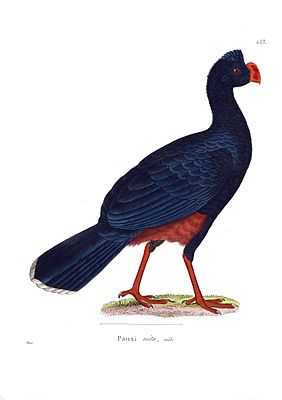With U
| With U | ||||||||||||
|---|---|---|---|---|---|---|---|---|---|---|---|---|

Mitu, illustrated by Nicolas Huet le Jeune in 1838 |
||||||||||||
| Systematics | ||||||||||||
|
||||||||||||
| Scientific name | ||||||||||||
| Mitu mitu | ||||||||||||
| ( Linnaeus , 1766) |
The Mitu ( Mitu mitu ), also known as the Northwest Mitu , Alagoas Mitu or Mituhokko , is an extremely rare species from the Hokko chicken family . It was originally native to the Atlantic coastal rainforest in the Brazilian states of Alagoas and Pernambuco .
Taxonomy
The Mitu was first mentioned by the German naturalist Georg Marggraf in his work Historia Naturalis Brasiliae , published in 1648. It was described scientifically for the first time in 1766. Until 1952, the Mitu was considered to be specific to the Amazon ( Mitu tuberosum , synonyms: Mitu tuberosa , Pauxi tuberosum , Mitu mitu , Crax mitu , Crax mitu tuberosa , Mitu mitu tuberosa ). Subsequently, it was seen as a northeastern subspecies of the Amazon coconut, whereupon it received the scientific name Crax mitu mitu (synonym: Mitu mitu mitu , Pauxi mitu ) in the specialist literature . Since 1992 Mitu mitu and Mitu tuberosum have been viewed by many scientists as two separate species.
features
The Mitu looks quite similar to the Amazon Kokko, but has a not so strong bulge on the beak. It reaches a size of 83 to 89 cm. The red beak has a helmet-like structure with a slight curve. It has a white tip. The plumage is generally black with a purple-blue tinge. It is maroon brown on the thighs, the under tail-coverts and the rump. The tail is narrowed towards the back and has a brown tip. The legs and toes are red and the eyes are reddish brown. Another characteristic is a small crescent-shaped pattern of bare gray-white skin on the back of the ear covers. In captivity, he can live to be 24 years old.
Danger
The Mitu is listed in Appendix I of the CITES Agreement and in the IUCN Red List as Extinct in the Wild ( extinct in the wild). Between 1648 and 1951 the Mitu was only known from a single museum specimen from Pernambuco. It remained hidden from ornithological experts until it was rediscovered in 1951 in Miguel dos Campos, Alagoas. Fewer than 20 specimens existed in the 1960s and 1970s, and in 1984 only two dead specimens were recorded in the wild. Merciless hunting due to its tasty meat and habitat destruction by the cultivation of sugar cane have made it extinct in the wild. In 1977 the Brazilian conservationist Pedro Mario Nardelli set up a breeding station in Nilópolis near Rio de Janeiro , in which there were four in 1979, 34 in 1993 and 44 in 2000. In the following period, other Brazilian bird parks and zoos kept Mitus, so that the total population was 81 in 2003, 130 in 2008 and around 230 in 2015. However, 35 percent of these individuals appear to be hybrids. In October 2015, a newborn Mitu chick was filmed for the first time in the Parque das Aves zoo in the Brazilian city of Foz do Iguaçu .
literature
- ET Grau, SL Pereira, LF Silveira, A Wajntal: Molecular markers contribute to a breeding program of the extinct-in-the-wild Alagoas Curassow Mitu mitu and confirm the validity of the species . In: Bird Conservation International . tape 13 , 2003, p. 115–126 ( PDF 89 kB [accessed on May 11, 2013]).
- Luís Fábio Silveira, Fábio Olmos, Adrian J. Long: Taxonomy, history, and status of Alagoas Curassow Mitu mitu (Linnaeus, 1766), the world's most threatened cracid . In: Ararajuba . tape 12 , no. 2 , 2004, p. 125–132 ( PDF, 84kB [accessed on May 11, 2013]).
Web links
- Birdlife factsheet (English)
- Characteristics of the Razor-billed currassow (English; PDF file; 191 kB)
- Mutum-de-alagoas vira símbolo de conservação (Portuguese)
- Mitu mitu inthe IUCN Red List of Threatened Species 2013.2. Listed by: BirdLife International, 2013. Retrieved January 30, 2014.

